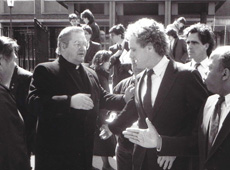The English love a military theme. Their bookstores are filled with vast sections on war, conflict and militaria. These volumes fly off the shelves. Still, I doubt Elizabeth Windsor or Camilla Parker-Bowles will want to peer through the foggy dew at a few long-range guns trundling past a reviewing stand in O’Connell Street at Easter 2016.
At a climactic moment in the current Dublin run of the National Theatre of Great Britain’s production of Warhorse , a play about the first World War, the cast sings a British army recruiting song called The Merry Ploughboy . If it sounds familiar to Irish ears, that’s because it is – it was number one in our own hit parade in the year of commemoration 1966. The words of the IRA ballad were almost identical – cannon roaring, helmets glistening, bayonets clashing, rifles smashing. No wonder Sean O’Casey joked that nationalism and imperialism had declined into one another’s headache. Such songs are hardly what commentators have in mind when they speak of England and Ireland’s “shared experience”. This one has long been dropped from RTÉ schedules.
Still, there are many consciously shared elements in our cultures. Thomas MacDonagh, a leader of the 1916 Rising, was a professor of English literature at UCD: he devoted his last class before the Easter break in that year to Jane Austen, ending with the comment: “Sure there’s nobody like Jane, lads.” And Patrick Pearse revered the poetry of Wordsworth.
Maybe something can be made of all this when members of the British royal family attend a commemoration of 1916. Let us hope their presence doesn’t put the whole country into lockdown – and that we really can use the event to interrogate the past.
The bittern cry
From this distance in time some of the similarities between the soldiers in the GPO and in the trenches are striking. The Meath poet and British soldier Francis Ledwidge may have anticipated a future joint ceremony in his beautiful lament for MacDonagh: “He shall not hear the bittern cry/ In the wild sky where he is lain/ Nor voices of the sweeter birds/ Above the wailing of the rain”. And the policemen who surrendered to Easter rebels after a fierce gun -battle in Ashbourne reminded their captors they were Irishmen too. They all believed it was sweet to die for country. Never such innocence again.
The myths surrounding both Easter 1916 and the first World War seem identical by now. England and Ireland mourned so many of its finest cut down in their prime. The felt mediocrity of life for many people in the 1920s and 1930s was often attributed to these losses. But this analysis, however moving, was a myth – despite dire losses affecting particular parishes, most of the combatants on all sides survived. James Connolly’s dire prediction came true: “the worship of the past could become a tactic to reconcile people to the mediocrity of the present”.
Unpaid volunteers
So citizens are right to be wary of commemorations. Connolly was wary himself. He realised that a people drunk on remembrance might run the risk of commemorating itself to death. Such events can assume a narrowly military character, as did the official Irish government commemoration in 1966. Yet the rebels being honoured were in fact unpaid volunteers, not salaried soldiers like their counterparts in the British army.
Fifty years further on, it is their ideas and writings which should be centralised – not their military uniforms. If our national Army partakes in commemoration, its role as international peace-keeper can be featured: after all, a major object of the Easter rebels was to take Ireland clean out of the war in Europe. Leaders of modern countries should be invited, along with our neighbours, to a great cultural event that incorporates Pearse and Connolly’s social vision, the poetry and drama not just of the rebels but of their honest critics in the wider revival debate.
The immense influence of the Irish independence movement in India, Latin America, Australia and the US should be recorded – if Collins provided a model for insurgents elsewhere, if de Valera has given his name to a street in India, then Yeats was the inspiration of the poets of decolonisation from Palestine to St Lucia.
Like it or not, the Irish Renaissance was world-historical in its day. It made soldiers in the trenches of Europe feel mutinous. It speeded the decline of deference to old- fashioned imperial philosophies. It gave rise to some masterworks of modernism – but it also embodied that militarism which frequently snuffed radical modernist ideas out, not just in Dublin or London or Berlin but, even more crucially, in the wider postcolonial world.
The coming commemorations are a chance to remind the wider world that we were indeed the first of the English-speaking peoples in the 20th century to walk towards decolonisation in terrifying and exhilarating darkness down what would become an ever more familiar road.
Declan Kiberd teaches Irish Studies at University of Notre Dame
© 2014 irishtimes.com

